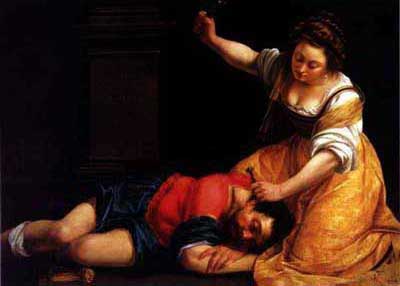Spiritual Sunday
Today’s Old Testament reading involves the Canaanite commander Sistera, most famous for having had a nail driven through his head by Jael, one of the few proactive women in the Old Testatment and an early Hebrew freedom fighter (at least in the eyes of the Jews). The story makes great use of small details:
Jael went out to meet Sisera and said to him, “Come, my lord, come right in. Don’t be afraid.” So he entered her tent, and she covered him with a blanket.
“I’m thirsty,” he said. “Please give me some water.” She opened a skin of milk, gave him a drink, and covered him up.
“Stand in the doorway of the tent,” he told her. “If someone comes by and asks you, ‘Is anyone in there?’ say ‘No.’”
But Jael, Heber’s wife, picked up a tent peg and a hammer and went quietly to him while he lay fast asleep, exhausted. She drove the peg through his temple into the ground, and he died. (Judges 4:18-21)
Throughout the ages, painters have been drawn to Biblical subjects where they could feature women, often their mistresses, in dramatic poses. It was a form of allowable erotica. I share today some passages about a painter in Anthony Trollope’s novel The Last Chronicle of Barset that becomes obsessed with painting a woman as Jael. Trollope develops their growing relationship with great comic effect as he shifts back and forth between the woman and the role she is playing. Here they are in their first encounter:
Miss Van Siever, who at this time had perhaps reached her twenty-fifth year, was certainly a handsome young woman. She was fair and large, bearing no likeness whatever to her mother. Her features were regular, and her full, clear eyes had a brilliance of their own, looking at you always stedfastly and boldly, though very seldom pleasantly. Her mouth would have been beautiful had it not been too strong for feminine beauty. Her teeth were perfect,—too perfect,—looking like miniature walls of carved ivory. She knew the fault of this perfection, and shewed her teeth as little as she could. Her nose and chin were finely chiselled, and her head stood well upon her shoulders. But there was something hard about it all which repelled you. Dalrymple, when he saw her, recoiled from her, not outwardly, but inwardly. Yes, she was handsome, as may be a horse or a tiger; but there was about her nothing of feminine softness. He could not bring himself to think of taking Clara Van Siever as the model that was to sit before him for the rest of his life. He certainly could make a picture of her, as had been suggested by his friend, Mrs. Broughton, but it must be as Judith with the dissevered head, or as Jael using her hammer over the temple of Sisera. Yes,—he thought she would do as Jael…
Upon further acquaintance, “Jael” begins to grow on the painter:
Miss Van Siever was shown into the room, and Dalrymple perceived that she was a girl the peculiarity of whose complexion bore daylight better even than candlelight. There was something in her countenance which seemed to declare that she could bear any light to which it might be subjected without flinching from it. And her bonnet, which was very plain, and her simple brown morning gown, suited her well. She was one who required none of the circumstances of studied dress to carry off aught in her own appearance. She could look her best when other women look their worst, and could dare to be seen at all times. Dalrymple, with an artist’s eye, saw this at once, and immediately confessed to himself that there was something great about her. He could not deny her beauty. But there was ever present to him that look of hardness which had struck him when he first saw her. He could not but fancy that though at times she might be playful, and allow the fur of her coat to be stroked with good-humor,—she would be a dangerous plaything, using her claws unpleasantly when the good-humor should have passed away. But not the less was she beautiful, and—beyond that and better than that, for his purpose,—she was picturesque.
Strict historical authenticity is beside the point. It’s all about the clothes:
And then on four different times the two ladies had to retire into Mrs. Broughton’s room in order that Jael might be arrayed in various costumes,—and in each costume she had to kneel down, taking the hammer in her hand, and holding the pointed stick which had been prepared to do duty as the nail, upon the forehead of a dummy Sisera. At last it was decided that her raiment should be altogether white, and that she should wear, twisted round her head and falling over her shoulder, a Roman silk scarf of various colors. “Where Jael could have gotten it I don’t know,” said Clara. “You may be sure that there were lots of such things among the Egyptians,” said Mrs. Broughton, “and that Moses brought away all the best for his own family.”
In the end, Jael does nail her man: she marries the painter.


